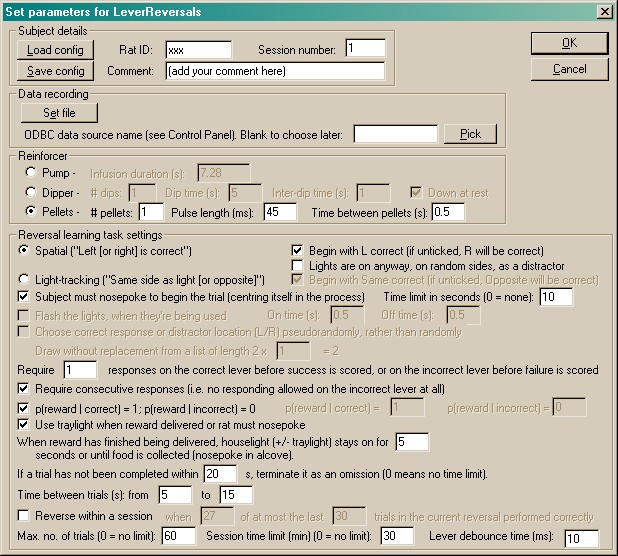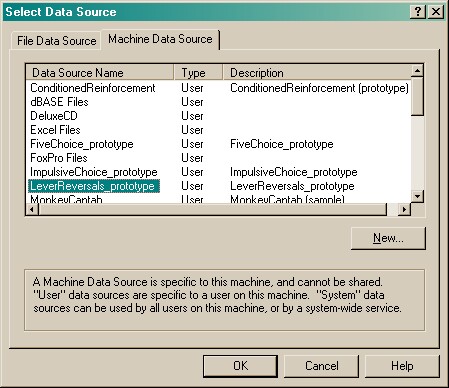The basic task runs as follows:
| • | Overall structure: trials are separated by intertrial intervals (ITIs). |
| • | In the ITI, the operant chamber is in darkness. |
| • | If the rat is to be required to nosepoke to initiate the trial, then the houselight (and perhaps traylight) will come on in the "pre-trial" state, until the rat nosepokes. A time limit can be set on this stage. |
| • | At the start of the trial itself, the houselight comes on (if it isn't on already) and two levers are extended. A light may also appear (and perhaps flash) above one or other of the levers. |
| • | The rat has to select the correct lever. This is either determined spatially ("the left lever is always correct" or "the right lever is always correct") or with reference to the light ("the lever on the same side of the light is always correct" or "the lever on the opposite side as the light is always correct"). The rat must discover this. |
| • | Once the rat has made a certain (user-specifiable) number of responses on the correct lever, it is rewarded (and the houselight will stay on for a while, and the traylight in the food alcove may also come on). Optionally, if it makes a response on the incorrect lever, or takes too long, it loses and the trial finishes. |
| • | To make things harder, the rat can be reinforced probabilistically (i.e. the probability of reward given that it does the right thing, or of reward given that it does the wrong thing) can also be set manually. |
| • | Overall trial number limits or session time limits can be set. |
| • | There is an option to select the correct response location pseudorandomly (so that there's a guarantee of equal number of left/right trials (in the case of the "same or opposite side as the light" task), or so the irrelevant distractor light (for the "spatial plus distractor light" task) appears equally left/right. This is done by drawing left/right locations "without replacement" from a list of a user-specified size. If the user specifies a value ("multiplier") of 1, then the list starts off by containing the values {Left, Right}. One is picked at random, without replacement, for each trial - so in every two trials, there's be one Left trial and one Right trial. If the multiplier was 3, then in every 6 trials there'd be guaranteed to be 3 Left and 3 Right trials, and so on. The larger the multiplier, the closer this pseudorandom behaviour is to genuinely random selection (in which there's no way for the subject to predict what's coming next, but there's always the possibility of very long sequences of, for example, Left trials). |
| • | This is a reversal task... so the experimenter can reverse subjects by hand (between sessions) by choosing whether the Left or Right response (in the case of the spatial task) or the Same or Opposite response (in the case of the light-tracking task) is correct at the start of each session. But there's also an option for within-session reversal, in which case the reversal can occur automatically when X trials within at most the last Y trials have been performed correctly by the subject. |
The parameters dialogue box looks like this:

To pick an ODBC database in advance of finishing, click Pick and you will be offered the ODBC Data Source picker (below). Your choice will be recorded and will apply to this subject from now on (or until you specify a different source).

If you don't specify an ODBC data source now, or you delete the value in the "ODBC data source name" box, you'll be asked to choose when the task ends (and that choice will only apply to the session in progress).